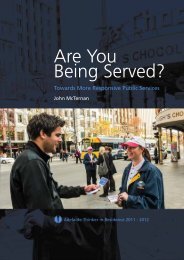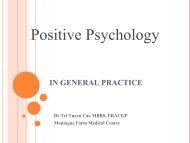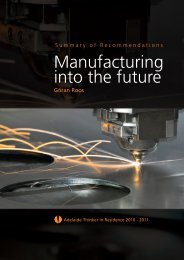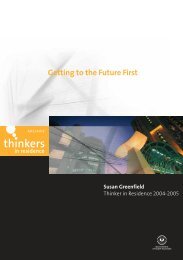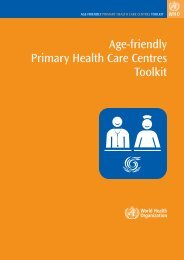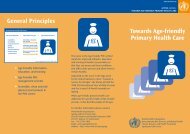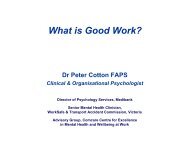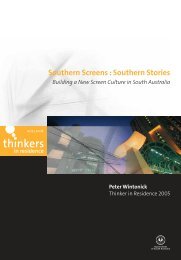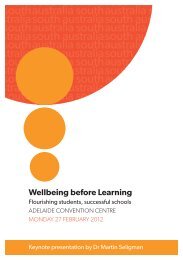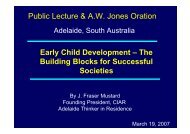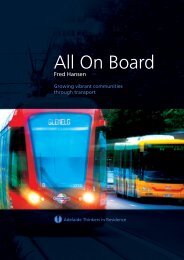Download pdf of Fred Hansen's report - Adelaide Thinkers in ...
Download pdf of Fred Hansen's report - Adelaide Thinkers in ...
Download pdf of Fred Hansen's report - Adelaide Thinkers in ...
- No tags were found...
You also want an ePaper? Increase the reach of your titles
YUMPU automatically turns print PDFs into web optimized ePapers that Google loves.
and various adverse health effects <strong>of</strong> <strong>in</strong>activity. This publication also conta<strong>in</strong>s an extensivebibliography <strong>of</strong> reference materials cover<strong>in</strong>g the field.In another part <strong>of</strong> her article Ms Lowrey cites research at the University <strong>of</strong> California–LosAngeles and Cal State–Long Beach thatAn additional study recently completed by the OECD entitled ‘Pedestrian Safety, UrbanSpace and Health’ 11 is another excellent work emphasis<strong>in</strong>g how the built environmentaffects how we get around, and how the constra<strong>in</strong>t <strong>of</strong> physical activity by that builtenvironment frustrates our ability to achieve better health outcomes for our community.Effects <strong>of</strong> transit-friendly neighbourhoodsIn a recent study 12 <strong>in</strong> my home <strong>in</strong> Portland, Oregon, populations were grouped <strong>in</strong> twocategories: those who lived <strong>in</strong> transit-friendly neighbourhoods and those who did not.And while the use <strong>of</strong> transport does not guarantee better health, what was found wasthat transit-friendly neighbourhoods had footpaths, safe street cross<strong>in</strong>gs and otheramenities that made walk<strong>in</strong>g easy.The study had clear results. Those liv<strong>in</strong>g <strong>in</strong> transit-friendly – read pedestrianfriendly– neighbourhoods weighed almost 6 pounds (2.7 kilos) less than thoseliv<strong>in</strong>g elsewhere. And their health reflected it as well. The cost <strong>of</strong> health care forthese <strong>in</strong>dividuals was approximately US$5500 less per year.Although not a part <strong>of</strong> this study, other research concludes that physical activity improvesmental health as well, provid<strong>in</strong>g a sense <strong>of</strong> greater well-be<strong>in</strong>g.In a recent article entitled ‘Your Commute is Kill<strong>in</strong>g You’ 13 , Annie Lowrey looks at research<strong>in</strong> Sweden as well as across the United States. The conclusions are clear: long commut<strong>in</strong>gdistances are generally disliked strongly, and the spill-over effect <strong>of</strong> this unhapp<strong>in</strong>esstranslates <strong>in</strong>to many other aspects <strong>of</strong> our lives.Ms. Lowrey notes that a survey conducted <strong>in</strong> 2010 for the Gallup-Healthways Well-Be<strong>in</strong>gIndex 14 found that 40% <strong>of</strong> employees who spend more than 90 m<strong>in</strong>utes gett<strong>in</strong>g homefrom work ‘experienced worry for much <strong>of</strong> the previous day’, but that the…number falls to 28% for those with negligible commutes <strong>of</strong> 10 m<strong>in</strong>utes or less.Workers with very long commutes feel less rested and experience less enjoyment,as well.Ms Lowrey also cites research from Thomas James Christian <strong>of</strong> Brown University <strong>in</strong> whichhe notes that ‘each m<strong>in</strong>ute you commute is associated with a 0.0257 m<strong>in</strong>ute exercise timereduction, a 0.0387 m<strong>in</strong>ute food preparation time reduction, and a 0.02205 m<strong>in</strong>ute sleeptime reduction’. It does not sound like much, but it adds up 15 . Long commut<strong>in</strong>g timesalso tend to <strong>in</strong>crease the chance that a worker will make ‘non-grocery food purchases’ –buy<strong>in</strong>g th<strong>in</strong>gs like fast food – and will shift <strong>in</strong>to ‘lower <strong>in</strong>tensity’ exercise.…looked at the relationship between obesity and a number <strong>of</strong> lifestyle factors, suchas physical activity. Vehicle miles travelled had a stronger correlation with obesity thanany other factor. 16Ms Lowrey poses the question ‘why do people suffer through’ so much time <strong>in</strong> the car,and answers it by not<strong>in</strong>g…a phrase forced on us by real estate agents: ‘Drive until you qualify’. Many <strong>of</strong> uswork <strong>in</strong> towns or cities where houses are expensive. The further we move from work,the more house we can afford. Given the choice between a cramped two-bedroomapartment 10 m<strong>in</strong>utes from work and a spacious four-bedroom house 45 m<strong>in</strong>utesfrom it, we <strong>of</strong>ten elect the latter.She concludes her article with the follow<strong>in</strong>g:But wait: Isn’t the big house and the time to listen to the whole Dylan catalog worthsometh<strong>in</strong>g as well? Sure, researchers say, but not enough when it comes to theelusive metric <strong>of</strong> happ<strong>in</strong>ess. Given the choice between that cramped apartment andthe big house, we focus on the tangible ga<strong>in</strong>s <strong>of</strong>fered by the latter. We can see thatextra bedroom. We want that extra bathtub. But we do not <strong>of</strong>ten use them. And weforget that additional time <strong>in</strong> the car is a constant, persistent, daily burden —if a relatively <strong>in</strong>visible one.Clearly this and other similar research tell us the same th<strong>in</strong>g. Liv<strong>in</strong>g <strong>in</strong> non-pedestrianfriendlyneighbourhoods comb<strong>in</strong>ed with spend<strong>in</strong>g substantial time <strong>in</strong> the car to meet life’sdaily demands is not healthy. And as health care costs soar here <strong>in</strong> South Australia as wellas around the world, and represent the fastest grow<strong>in</strong>g government cost, someth<strong>in</strong>g mustchange before these costs bankrupt government.Creat<strong>in</strong>g walkable, liveable and susta<strong>in</strong>able neighbourhoods at times seems more <strong>of</strong> anart than a science. We try to put all the th<strong>in</strong>gs together which have made other areas <strong>in</strong>tojust what we want. In do<strong>in</strong>g so we have seen great successes around the world, be they<strong>in</strong> some <strong>of</strong> our great cities such as Paris, London or New York, or <strong>in</strong> newer cities such asPortland, and the Pearl District, where we have created wonderful neighbourhoods out <strong>of</strong>low-value abandoned rail yards. Through the <strong>in</strong>vestment <strong>in</strong> tram <strong>in</strong>frastructure, <strong>in</strong> parksand other amenities, areas have been transformed to make them places where peoplewant to live, work and play.The 20-m<strong>in</strong>ute neighbourhoodEven if mak<strong>in</strong>g excit<strong>in</strong>g urban neighbourhoods is both science and art, there are more11Pedestrian Safety, Urban Space and Health, the Research Centre <strong>of</strong> the International Transport Forum at thequantifiable approaches that are outcome based and can help tell us if we are successful.Organisation for Economic Cooperation and Development (OECD), 2011One approach that is ga<strong>in</strong><strong>in</strong>g popularity around the world is the idea <strong>of</strong> the 20-m<strong>in</strong>ute12Presentation by Mel Rader <strong>of</strong> Upstream Public Health, to the Jo<strong>in</strong>t Policy Advisory Committee onneighbourhood.Transportation, METRO, Portland, Oregon, USA (10 September 2009)13http://www.slate.com/id/2295603/26may201114http://www.gallup.com/poll/142142/wellbe<strong>in</strong>g-lower-among-workers-long-commutes.aspx15http://papers.ssrn.com/sol3/papers.cfm?abstract_id=1490117 16http://www.sciencedirect.com/science/article/pii/S1353829205000572H E A L T H Y C O M M U N I T I E S38 FRED HANSEN: ALL ON BOARDFRED HANSEN: ALL ON BOARD 39




